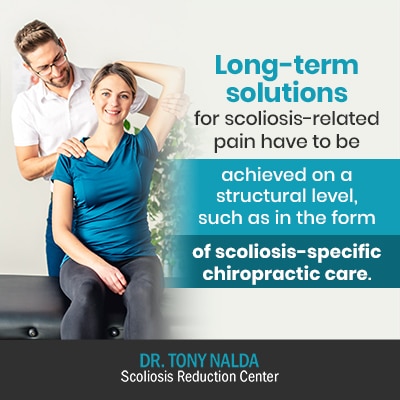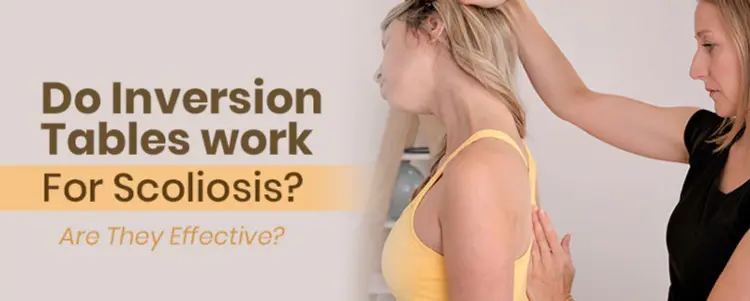Inversion tables can be effective for addressing a number of back issues related to a compressed spine and/or stiff and sore muscles. When it comes to scoliosis, its effects are more indirect, as inversion tables can’t actually address the underlying cause of scoliosis by inducing a structural change, but can be associated with certain therapeutic benefits.
Inversion therapy involves the body being upside down, or held at an inverted angle. As adult scoliotic curves settle due to skeletal maturity and gravity, inversion tables can reverse the gravitational effect on the spine, relieving compression, but it doesn’t have the power to induce a structural change.
Scoliosis is a structural condition, meaning to be treated effectively, it has to be impacted on a structural level. While many types of therapy and treatment can help relieve scoliosis-related pain, few can induce a structural change in the form of a curvature reduction; this is why I don’t generally recommend them for scoliosis treatment specifically, but more for pain relief, scoliosis-related or other types of back pain. Let’s explore what inversion therapy entails and if it has a place in scoliosis treatment.
As is the case with any form of therapy and/or treatment, inversion therapy, and the use of an inversion table, shouldn’t be attempted without professional guidance and without first consulting the provider of your scoliosis treatment.
What is Inversion Therapy?
Before we get into the specifics of the use of inversion tables in scoliosis treatment, let’s first explore the concept and methodology behind inversion therapy.
Inversion therapy is based on the concept that reversing the gravitational force on the body removes compression causing muscles, bones, and joints in the back to compress the spine.
Being inverted simulates a lengthening motion experienced by the spine, allowing it to fully stretch and increase space between the vertebrae (bones of the spine), the intervertebral discs, and takes pressure off multiple areas of the back, including its muscles, vessels, and nerves.
A lot of back pain comes from stiffness and compression. When the spine is inflexible and becomes more rigid, it places excess strain on its surrounding muscles, and this can lead to back pain in the form of sore and tight muscles, not to mention the feeling of having a spine that is excessively stiff, tight, and inflexible.
The lengthening motion delivered through inversion can be achieved through performing handstands, headstands, hanging upside down from a bar, or with the use of an inversion table.
What Can Inversion Therapy Achieve?
As the body’s own weight is used to counteract the force of gravity, it can decompress the joints of the body, including the spine.
Inversion therapy is based on the principle of spinal traction (stretching the spine), and this can be an effective means of providing relief from a variety of back pain sources; however, pain relief achieved this way is short lived as once the body is no longer inverted, the spine is once again subject to gravity and compression.
In addition, there are certain risks involved with remaining inverted for long periods of time such as a slow heart rate and/or high blood pressure.
Inversion tables that involve patients hanging from their feet allow the spine’s joints to be loaded equally and opposite to where they are in a regular upright position of spinal alignment.
The spinal-stretching effect is an inversion-table benefit as it can temporarily increase the space between the vertebrae, which are stacked on top of one another and separated by intervertebral discs.
This can bring therapeutic benefits such as helping to replenish the discs, as they don’t have their own vascular supply, and allowing the spine more flexibility and space to be manipulated through chiropractic care.
Inversion tables are often debated for their effectiveness in treating scoliosis, particularly in cases of straight-back syndrome, prompting questions regarding their efficacy.
When considering the effectiveness of inversion tables for scoliosis, it’s essential to research and select the best inversion chair that suits your needs and consult with a healthcare professional, as improper use or a heavy-duty inversion table can potentially hurt your back.
Now that we’ve discussed the concept and methodology of inversion-table benefits, let’s connect the subject to scoliosis.
Adult Scoliosis and Inversion Therapy
When a person has scoliosis, it means they have an abnormal sideways spinal curvature that rotates. Although the spine is naturally curved to give it added strength, flexibility, and to help evenly distribute stress throughout, it can also develop unnatural curves that adversely affect the spine’s overall biomechanics.
As a scoliotic curve develops, the spine’s vertebrae become misaligned, and as scoliosis is progressive, if left untreated and the curvature gets larger, the spine becomes more misaligned, commonly causing postural changes and pain (in adults).
The reason inversion therapy is more commonly used in adult scoliosis, but not child and adolescent scoliosis, is because of skeletal maturity and gravity.
In children and adolescents who are still growing, their spines are experiencing a constant lengthening motion already, and this counteracts the compressive force of the curvature on the spine and its surroundings, relieving pain.
Adults, however, experience scoliosis-related pain very differently, so inversion therapy can bring temporary pain relief for adults, although only for short periods of time.
Pain Relief
In adults who have reached skeletal maturity, their spines have settled due to gravity and the fact that they are no longer growing. Scoliosis can lead to compression of the spine and its surrounding muscles, vessels, and nerves; inversion-table benefits include reversing the gravitational effect on the spine, thus relieving compression by taking pressure off the spine and its surroundings.
For the opposite reason, scoliosis is not often painful in younger patients who are still growing as the spine’s lengthening motion counteracts the compressive force of the curvature.
While inversion tables can help provide relief from pain, that relief will be short-lived as when the body is no longer inverted, the spine settles again due to gravity, feeling the effects of compression and related pain.

Long-term solutions for scoliosis-related pain have to be achieved on a structural level, such as in the form of scoliosis-specific chiropractic care.
Exploring the effectiveness of inversion tables for scoliosis, including their potential impact on the reversal of cervical lordosis, and lumbar lordosis is essential for those seeking alternative treatments for spine-related issues.
So inversion tables can be an effective form of short-term pain relief for adults, but are there other benefits when used as a form of adult scoliosis treatment? There are, in fact, some additional positive effects that inversion therapy can offer when used in conjunction with other treatment disciplines.
Core Strengthening
It’s not just the spine that works to maintain its healthy curvatures; it’s also its surrounding muscles that provide support and stabilization.
Inversion tables can also be used to increase abdominal strength by performing crunches and sit-ups while engaging the core and targeting the muscles surrounding the spine.
However, it’s important to remember that increasing core strength, while a positive aspect of an integrative scoliosis treatment approach, is only one aspect, and on its own cannot impact the condition on a structural level or realign the spine.
In addition to pain relief and core strengthening, inversion tables are also thought to play a possible role in postural correction.
Posture Correction
Some believe that inversion therapy, and the use of inversion tables, can help correct poor posture, improving the spine’s overall health and biomechanics.
As the spine and its surroundings are stretched and relieved from the uneven forces and pressure that scoliosis introduces, blood flow to multiple areas of the back is increased and has the potential to reduce back spasms.
Increased blood flow can be particularly beneficial to the intervertebral discs as they don’t have their own vascular supply, which is why they commonly experience degenerative changes through aging and certain lifestyle choices, such as poor posture.
The intervertebral discs play an important role in providing the spine with flexibility, cushioning for the vertebrae, and maintaining its healthy curvatures and alignment.
So while inversion therapy can increase blood flow, which is beneficial for the musculoskeletal system as a whole, and is particularly good for the spine’s intervertebral discs and relieving strain caused by poor posture, structural scoliosis is not caused by poor posture alone, nor can it be treated by inversion therapy alone.
Do Inversion Tables Work for Treating Scoliosis?
The important thing to remember is that scoliosis is structural. Any form of treatment or therapy that mainly addresses related pain or only produces short-term effects, is merely addressing a symptom of scoliosis, not the scoliosis itself; there is a big difference between the two when it comes to treatment efficacy.
Here at the Scoliosis Reduction Center®, we don’t want to just impact a patient’s scoliosis in terms of its symptoms, but rather to address its underlying cause by inducing a structural change in the form of a curvature reduction.
We also work towards strengthening the spine and its surrounding muscles so it can better support and stabilize itself, while preserving its function.
Conclusion
Scoliosis is not a simple condition and necessitates an integrative approach when it comes to treatment.
So do inversion tables work for treating scoliosis? If an inversion table was used to augment structural changes achieved through a combination of scoliosis-specific chiropractic care, in-office therapy, custom-prescribed home exercises, and specialized corrective bracing, it might have a place in providing short-term scoliosis pain relief and facilitating some therapeutic benefits for adults; however, there is little-to-no data supporting a clear connection between inversion therapy and successful long-term scoliosis treatment.
Inversion tables counteract the gravitational force on the spine and its surrounding muscles, vessels, and nerves, which is known to cause compression and pain. The stretching of the spine can help work towards keeping the spine and its surroundings as loose and flexible as possible, but these effects are short lived as when the body is no longer inverted, the gravitational force and compression returns.
The only truly effective way to treat scoliosis long-term is to impact it on a structural level, as this addresses its true nature and underlying cause.
Here at the Scoliosis Reduction Center®, we offer our patients a functional chiropractic-centered approach that combines multiple treatment disciplines to offer patients all the potential benefits of inversion therapy and more: pain relief, core strengthening, postural correction, and curvature reduction.





